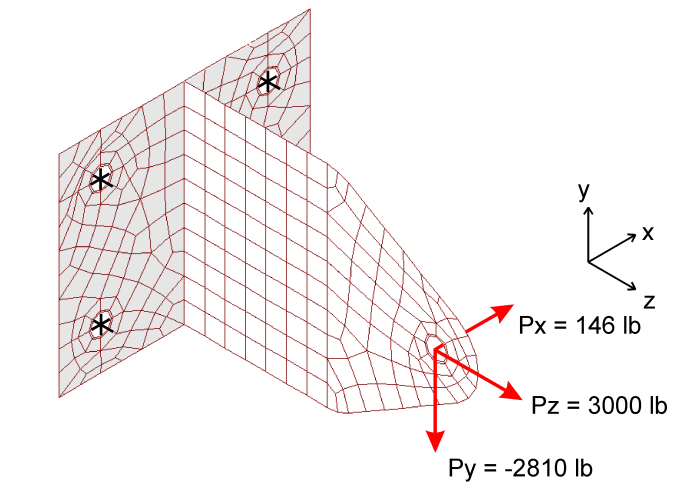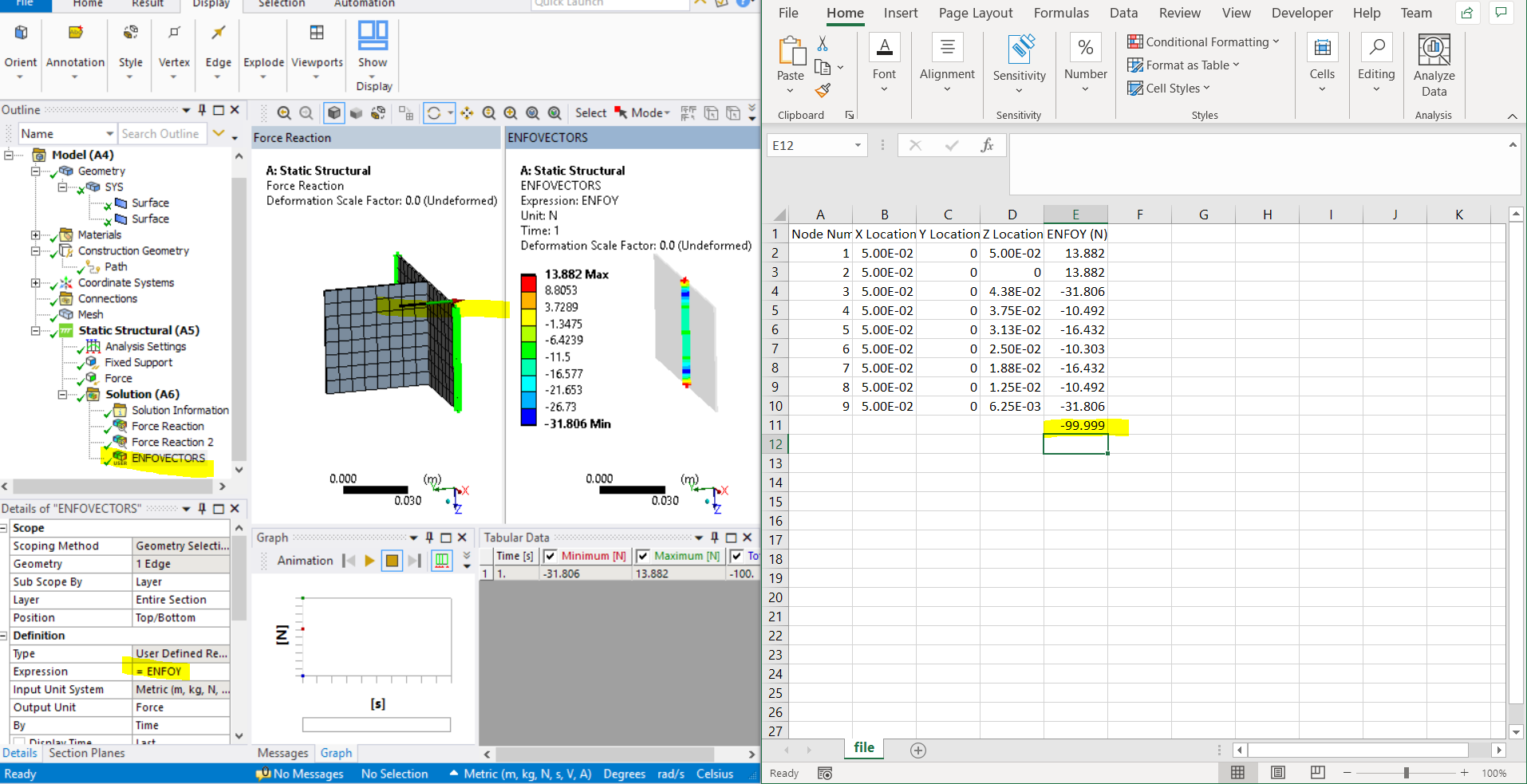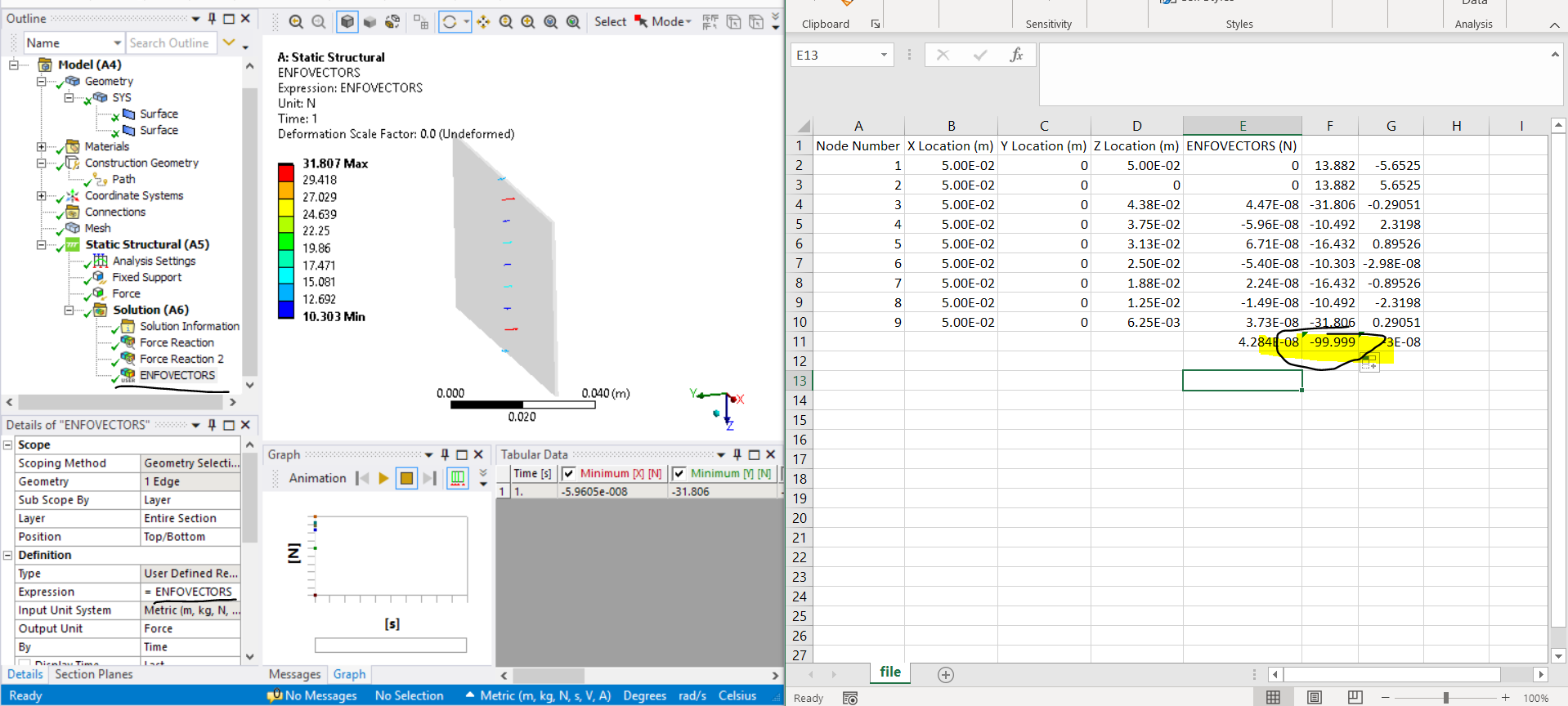TAGGED: ansys-workbench
-
-
June 3, 2021 at 1:01 pm
DoodlerD
SubscriberHi,
I'm trying to extract averaged internal nodal forces along an entity. They show values that are wrong. What could be the error? I have turned on nodal forces in the analysis settings.
June 4, 2021 at 6:42 am1shan
Ansys EmployeeI hope you have checked the units. What is the direction and value of force on the bracket? Also, what does the command snippet do? Could you also try FZ (this works only on constraint nodes) instead of ENFOZ and see if anything changes?
Regards Ishan.
June 4, 2021 at 1:34 pmDoodlerD
SubscriberThank you.
The units are fine, the command snippet is to activate ENFO, since it is missing in the solver worksheet. The value of forces are as described below. I'm running a set of benchmarks with Ansys after moving from a Nastran environment. I dont think Fz helps. However, I was able to work with the stress tensor and take the longer route. I'm not sure why ENFO does not work in my case.

June 4, 2021 at 1:59 pmErik Kostson
Ansys EmployeeHi
I have made a simple example to show how one can do this perhaps - I am used to working with the element-nodal force vectors when designing saying connections so that is the udr I have used as shown below. We can then export the results to excel and sum the element nodal force to obtain the total reaction which -100 N as shown, and is as expected equal and opposite to the applied load which is 100 N in this example. I think as shown it can be done also with ENFOY.
Should be said here, that mesh is fully compatible at the intersection of the two plates so no contacts - if we have contacts then we can get the reaction at the contact with a contact/force reaction probe (under the force reaction probe we can choose to look at the contact region).


Hope this helps
June 4, 2021 at 2:07 pmDoodlerD
SubscriberThank you for looking into it.
What is the 'elemental-nodal' force value? is it nodal or elemental? How is Ansys interpolating this value and where can I read about it. A google search is giving me limited results.
June 4, 2021 at 2:10 pmErik Kostson
Ansys EmployeeNo worries - it is the internal forces between elements , so forces within the mesh (so not fixed boundary nodes) which I mean with element nodal force (ENFO)- it is a general term. not sure if it is described. ELement Nodal force is not interpolated as far as I know, they are "raw" and they are the internal forces that provide equilibrium.
Finally in the above example we need to sum (use SUM() function in excel) manually in order to get the total force (ansys provides the force at each node of the element so we need to sum them all)
June 7, 2021 at 3:42 am1shan
Ansys EmployeeThanks for working it out !!!
Check this out - 1. Solution Output, 2. Interpolation.
The documentation states that "Interpolation primarily applies to degree of freedom results such as temperatures, displacements, and node-based element results like thermal flux, stress, and strain. Therefore, it is recommended that you not use interpolation for results such as node-based element reactions (EHEAT/ENFO). The application allows for these calculations, but they are not good candidates for interpolation. In addition, you should not sum interpolated results of these types; such as to calculate total heat or total force"
Regards Ishan.
How to access online help ? - /forum/discussion/22563/using-help-with-links#latest.
Viewing 6 reply threads- The topic ‘ENFOZ, ENFOY Gives Wrong Results.’ is closed to new replies.
Ansys Innovation SpaceTrending discussionsTop Contributors-
3762
-
1333
-
1168
-
1090
-
1014
Top Rated Tags© 2025 Copyright ANSYS, Inc. All rights reserved.
Ansys does not support the usage of unauthorized Ansys software. Please visit www.ansys.com to obtain an official distribution.
-
The Ansys Learning Forum is a public forum. You are prohibited from providing (i) information that is confidential to You, your employer, or any third party, (ii) Personal Data or individually identifiable health information, (iii) any information that is U.S. Government Classified, Controlled Unclassified Information, International Traffic in Arms Regulators (ITAR) or Export Administration Regulators (EAR) controlled or otherwise have been determined by the United States Government or by a foreign government to require protection against unauthorized disclosure for reasons of national security, or (iv) topics or information restricted by the People's Republic of China data protection and privacy laws.












